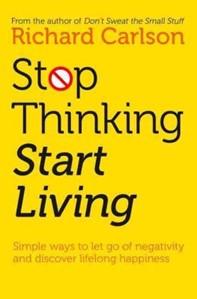I have recently been reading an excellent book. I stumbled across it because a client recommended it. It’s called ‘Stop Thinking, Start Living’, and it’s by Richard Carlson. It is in fact a few years old now having been written in the 1990s but is quite brilliant in its simplicity.
 The essence of the book is that Richard believes those of us prone to thinking a lot may be at risk of encouraging mild to moderate depression. This is because our every moment is involved in thinking. Thinking isn’t a bad thing, or a problem if we are constructive about it, problem solving issues or making decisions where needed. But instead, many of us are ruminators, prone to revisiting problems over and over. Looking for the answer within the problem he believes, does nothing more than deepen the discomfort of it for us. If anything, it positively promotes or deepens our troubles.
The essence of the book is that Richard believes those of us prone to thinking a lot may be at risk of encouraging mild to moderate depression. This is because our every moment is involved in thinking. Thinking isn’t a bad thing, or a problem if we are constructive about it, problem solving issues or making decisions where needed. But instead, many of us are ruminators, prone to revisiting problems over and over. Looking for the answer within the problem he believes, does nothing more than deepen the discomfort of it for us. If anything, it positively promotes or deepens our troubles.
Instead, Carlson believes we should tackle problems as they occur, roping as many people in for advice is needed, then we must learn to ‘park’ it. Parking it as a habit, teaches our brains discipline, a form of discipline that stops us playing and replaying the scenarios we are dealing with and enables us to get on with living.
Living he feels, involves recognising several things: –
1. Life is not an emergency. We are all in a hurry these days and rush about doing as much as we can, fitting so much in to a day that we are ‘meant’ to feel efficient. Yet stress is typical of any or all of us who persistently feel ‘hurried’ so would we get more done if we slowed down and try to enjoy it as we go?
2. He recognises our readiness to dwell on our troubles is often based on slights from the past, events we were part of, regrets or things we feel saddened by. Things people have said to us, feelings attached to those, and reasons to berate ourselves or others, are also sources of our distress. Consequently, we spend time in silent conversations in our heads with things we would have liked to have said and cutting remarks that might have helped us feel better if we had come up with them at the time. The problem is all this does is start-up the angst, anger, or upset all over again. Often years have passed, and we are still doing this!
3, If we are not living in the past, we live for the future, concentrating on feeling ‘when ‘x’ happens, then it will be ok’; or ‘I will be happy when ‘Y’ takes place’. We pin our happiness on some arbitrary date in the future when all will be well. Carlson suggests all this does is emphasise how we ‘wait’ for things. So, between rushing to achieve, and waiting for the future, we aren’t living in the ‘now’.
In many ways, living for now, staying in the moment, and therefore concentrating on enjoying current experiences, is about mindfulness. (http://mindfulness.soulnutrition.org/appreciatingwindowsills/ )
Although mindfulness is based on a philosophy, the experience of Buddhism and the values therein, most of us have come across it and understand that its essence is to ‘stay in the moment’ and live for now. Mindfulness has only been proposed to the general populace in the last few years, so my feeling is this book literally predates it and yet without calling it such, he seems to be referring to a discipline of mind and action that is very similar to the teaching of mindfulness.
This brings me neatly to what the book really talks about. To me it’s value is in helping ALL of us to recognise happiness lies less within the action of others, and A LOT more within the ability, and control, of our own mind and body. This may not feel a revelation, but to be given the tools to do this is of value. Otherwise, we can recognise the importance of thinking negatively and the value in avoiding that, but we don’t actually know how to stop it!
As a practitioner and stress expert, I am not sure that I understand how avoiding looking at a problem is the total solution to your difficulty with it. It seems to me, there is some merit in investigating it. By investigating it or looking deeper, you are tackling or analysing the situation itself, the characteristics or features of it, your emotional attachment to it, and therefore you develop the ability to detach from it. This is at the root of the incredibly useful and profound tool of latter years, which is the therapeutic intervention called EMDR. Eye Movement Desensitisation and Reprocessing is based on the principle that the brain cannot equally pay attention to 2 things at once. Therefore, when someone starts to relive an event and talk about it, the anxiety they feel about the event begins to increase in their body. As it increases it shuts down the problem-solving capacity of the brain because this is the natural stress response which deliberately forces you to get out of the situation rather than stand still and risk whatever threat is coming at you. Just because the threat is in your mind doesn’t make any difference to the stress response, it will still try to shut down your problem-solving so that you push the problem away and run. The principal of EMDR is that a practitioner uses either their finger and moves it from side to side in a rhythmic motion, or they have a gadget that might look like a metronome – the type people use to learn the piano. Either of these tools mean the brain and your eyes concentrate on the movement, enabling the practitioner to talk to the individual at the same time and your body cannot trigger the anxiety response in that situation to the same degree.
Improvements can be significant in stressful situations such as car accidents, distress over something somebody has said to you, and the reliving of situations you feel unable to face. Highly qualified practitioners have had significant success with post-traumatic stress disorder such as that in combat soldiers using EMDR.
If you are interested in this try watching the you tube explanation here: https://www.youtube.com/watch?v=hKrfH43srg8
You can also find a practitioner here: https://www.findatherapy.org/emdr if you have suffered from trauma, or something you feel would benefit from treatment.
Within the book there are some excellent paragraphs that feel revolutionary in their attempt to explain how we all do a lot of thinking, but it’s not the fact that we do this which is really the issue, it’s those of us who sit and dwell on it which creates the trouble. Ruminators as I call them, find it almost impossible to stop thinking a lot and in doing so revisit situations over and over including those that are in the past. Yet there are a few observations I’d make which are intended to help: –
1. Every day you live your life everything you have been through becomes your past moments later. Your brain cannot pay attention to everything it experiences and remember all these events equally. So, it will attempt to prioritise them. What you remember are the events you decide to filter as important. So, be careful to avoid filtering every conversation and every situation through some kind of ‘alert for threat’ filter because in your lifetime many things you experience will be good and some of them will be tough, but that’s normal.
2. If you have done something you don’t like then re-visit it ONCE. Allocate a rating to it. Between 1 and 10 where 9 or 10 are bad and 5 or less not worth it. If you scored it a 9 or 10, then decide about how you feel, and is there ANYTHING you can do to sort it. If there is DO IT. Apologise or accept partial, or total, responsibility. Honesty, transparency, and contrition go a long way towards earning forgiveness.
3. If it scored a 5 or less DUMP it! In another week or month, it will become history and not worth your scrutiny otherwise almost everything you go through can, and often does, make you unhappy.
If you don’t find this simple tool useful you may like to read the book which is available from Amazon or wait until our next blog which is a review and critique of it and most of the tools are summarised and easy to understand.


0 Comments